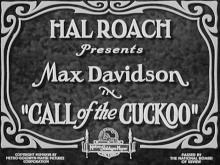| Call Of The Cuckoo | |
|---|---|
 | |
| Directed by | Clyde Bruckman |
| Written by | H.M. Walker (titles) |
| Produced by | Hal Roach |
| Starring | Max Davidson |
| Cinematography | Floyd Jackman |
| Edited by | Richard C. Currier |
| Distributed by | Metro-Goldwyn-Mayer |
Release date | October 15, 1927 |
Running time | 17 min. |
| Country | United States |
| Languages | Silent film English intertitles |
Call of the Cuckoo (1927) is a Hal Roach two reel silent film released by Metro-Goldwyn-Mayer.[1] The film's principal star is comedian Max Davidson, though the film is just as well known for cameos from other Roach stars at the time. These cameos include renowned supporting player Jimmy Finlayson (the source of Homer Simpson's "D'oh!" catchphrase), the oft underrated/ignored Charley Chase, and a pre-teaming Stan Laurel and Oliver Hardy.[2]
YouTube Encyclopedic
-
1/3Views:51 2693 0391 872
-
Cuckoo | Tamil Movie Comedy | Attakathi Dinesh | Malavika | Murugadoss
-
Cuckoo | Tamil Movie | Scenes | Clips | Comedy | Songs | Dinesh and Malavika Nair visits Eswar
-
Cuckoo | Tamil Movie | Scenes | Clips | Comedy | Songs | Dinesh and Malavika plan to get married
Transcription
Plot
Papa Gimplewart (Davidson) exchanges his house, in order to escape the antics of inmates of the lunatic asylum next door, including characters played by Laurel and Hardy. Unfortunately, the new house turns out to be 'Jerry-built', put up in two days. After several disasters occur, Papa Gimplewart asks "Is there anything else can happen?". He then realizes that the inmates from the asylum have just moved in next door.
Among the disasters are a mop removing the color from the kitchen floor, dirty bath water leaking down from upstairs and into the communal coffeepot, and a piano sliding on an uneven floor that crashes through a wall and demolishes the family car.
Excerpts from this film appeared in the Robert Youngson 1965 documentary Laurel and Hardy's Laughing 20's.
Cast
- Jimmy Finlayson
- Charley Chase
- Max Davidson
- Lillian Elliott
- Stan Laurel
- Oliver Hardy
- Spec O'Donnell
- Leo Willis
- Frank Brownlee
- Edgar Dearing
- Otto Fries
- Charlie Hall
- Fay Holderness
- Charles Meakin
- Lyle Tayo
See also
References
- ^ Call of the Cuckoo at silentera.com Retrieved May 10, 2017
- ^ The Call of the Cuckoo; allmovie.com Retrieved May 10, 2017
